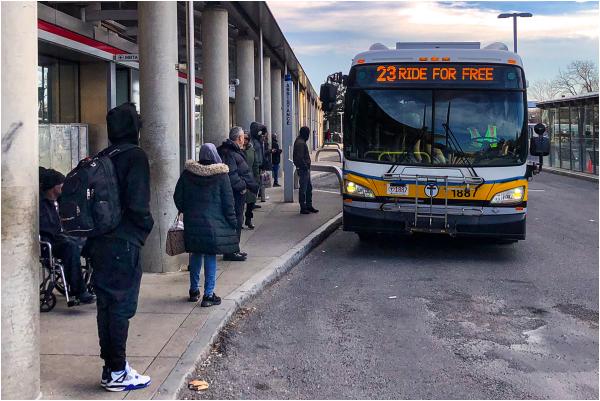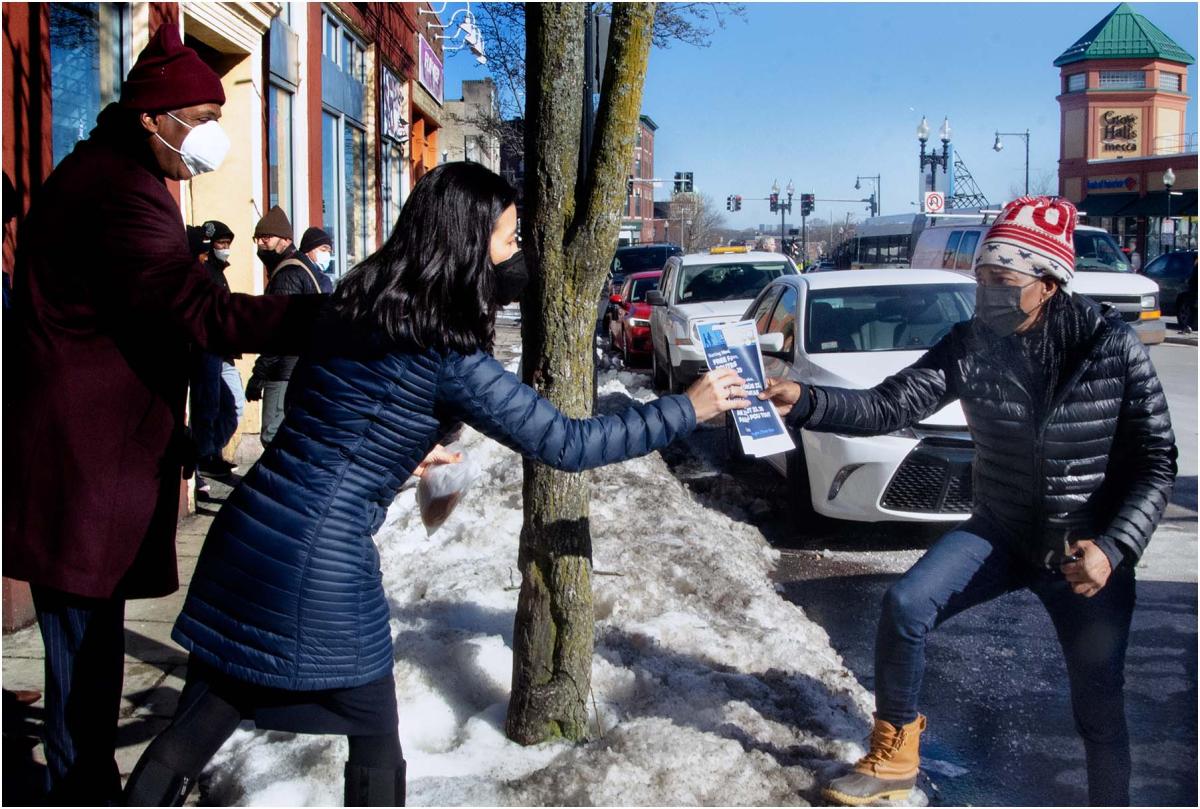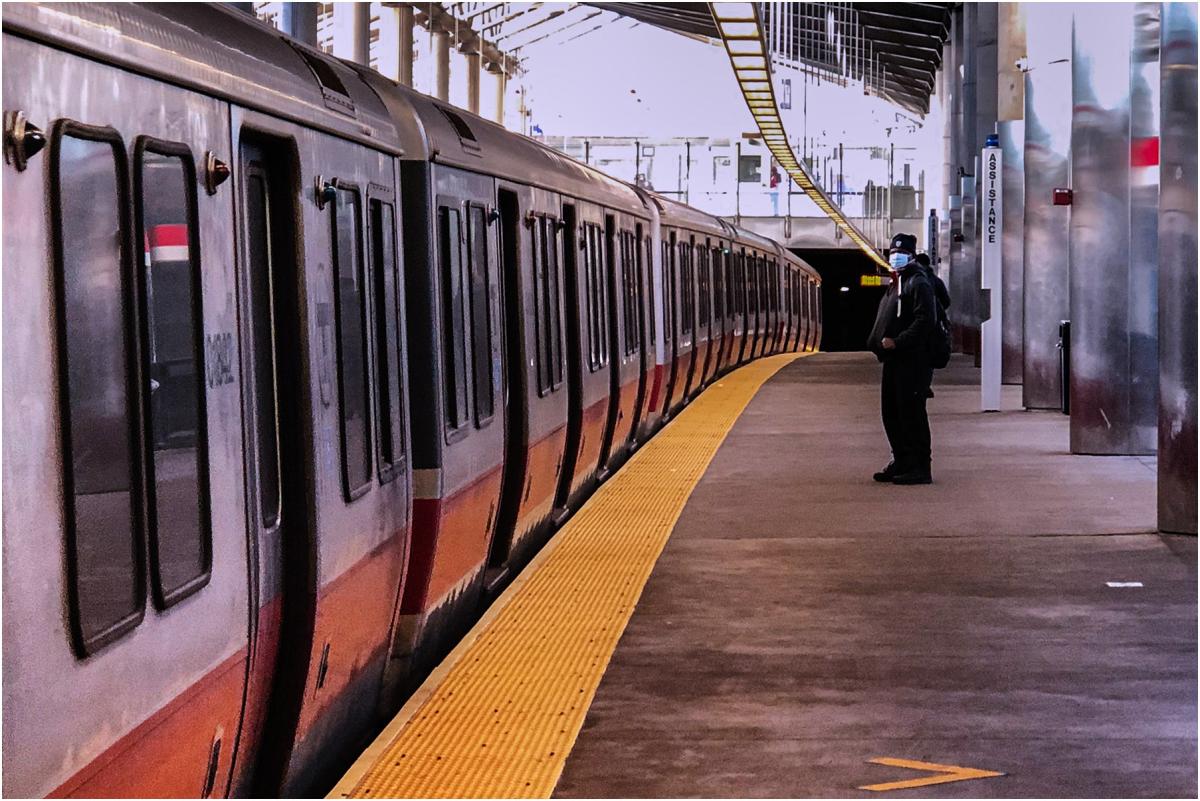February 13, 2024

A 23 bus pulled up to the curb at Ashmont Station on Sat., Feb. 10. Chris Lovett photo
After a long grassroots push for better and more affordable public transportation, the MBTA will offer systemwide fare discounts for low-income riders as early as this summer, pending final approval from the agency’s board.
MBTA and state officials outlined plans for the discount service at a briefing on Monday. By using Charlie Cards, eligible riders would get discounts of about 50 percent on all modes of service, from bus and subway lines to commuter rail, ferries and the RIDE. The program would be for low-income riders ages 26-64 and non-disabled. The agency already has targeted discount programs for riders with disabilities.
“Regular riders of our system can save over $700 annually, and those who regularly use commuter rail could save nearly $2,000,” Lynsey Heffernan, the MBTA’s Chief of Policy and Transit Planning, said at the briefing. “From previous research,” she said, “we know that when riders with lower income are provided with reduced fares, they will take 30 percent more trips and that they will take more trips to healthcare and social services.”
Officials estimate the 60,000 riders would be eligible who are currently enrolled in state assistance programs that have a cutoff no higher than 200 percent of the federal poverty level (slightly less than $41,000 a year for a household of two).
“Applying for this and receiving the discount will be as will be easy. Data integration efforts will allow a seamless verification process to accelerate application approvals and streamline getting discounted passes into the hands of low-income riders,” said Michael Cole, Deputy Commissioner, Policy and Programs for the state’s Dept. of Transitional Assistance.
Community groups and transportation advocates have been calling for the systemwide fare discount since at least 2019, following earlier campaigns against fare increases and for improved service. A statewide partnership of transit workers and riders, Public Transit Public Good, applauded the decision to fund the discounted service in Governor Maura Healey’s FY25 budget, with support from the legislature.
“Governor Healey’s bold commitment to funding a low-income fare program will transform the lives of tens of thousands of people who count on the MBTA to live their lives with freedom and ease – to get to work, to medical appointments, and to take their children to school,” the group posted on its website.

Mayor Wu is shown in Grove Hall at an event to promote the fare-free bus service pilot program. Chris Lovett photo
The move to lower fares comes amid reports of a funding gap for the MBTA, but also after the introduction of free service on three bus lines going through Dorchester, Mattapan and Roxbury. The service began under former Acting Mayor Kim Janey, later expanding under the current Mayor, Michelle Wu.
Advocates for free service argue that it would eliminate time spent on fare collection, while allowing buses to open multiple doors, so passengers could board or get off more quickly. But supporters of systemwide fare discounts note these could help bus riders connecting with transit lines. And, unlike the current free service on bus routes 23, 28 and 29, the systemwide discounts would be means tested.
Citing a 2019 MIT study, Steven Povich, the MBTA’s Senior Director of Fare Policy and Analytics, projected that the increase ridership by passengers enrolled for the discount would even surpass even the gain for the three bus routes currently offering free service. He acknowledged that the routes had less “dwell time” per passenger, but that this was offset by an increase in the number of riders.
“In terms of the fare-free bus program in partnership with the City of Boston,” said Povich, “we've seen about a 20 percent increase in ridership on the 23, 28 and 29 bus routes. And, in terms of the speed of those buses by opening all doors and removing the fair collection function, we've seen about a 20 percent decline in dwell time per rider.”
The Executive Director of the LivableStreets Alliance, Stacy Thompson, said the low-income fares should be combined with expanded free bus service, as part of a “suite of solutions.” Since many riders use buses as feeders to paid service on other lines, she also argued that the benefits of charging bus fares have to be weighed against the cost and time needed for collection, which can lead to conflicts between drivers and passengers—or spotty collection on some lines.
“We are already doing that,” she added, “because fare collection is really inefficient and really expensive, and hard to do, so it’s very reasonable to ask harder questions about why we’re collecting fares in the first place and if it’s actually an effective solution for us.”

A lone rider waited for a Red Line train on the platform at Ashmont Station on Sat., Feb. 10. Chris Lovett photo
In a statement prepared for the briefing, the discount fare proposal was hailed by a longtime community advocate, Mela Bush, co-chair of the Fairmount Indigo Transit Coalition and former director of the T Riders Union.
“The low-income fare policy has come at a time of skyrocketing costs on food, housing, etc.,” said Bush. “Saving $500 a year on transportation for lower-income transit-dependent people can mean so much! For so long, we fought against fare increases for those who could not afford it.”
In a statement Monday, District 4 (Dorchester/Mattapan) City Councilor Brian Worrell comments, “Public transportation is a public good and it's great to see state and city leaders work together to enact policy that benefits the residents and neighborhoods that need it most. It is crucial that we continue to sustainably invest in policies that are proven to make an impact. The bus pilot has proven to be effective, but when the ARPA (American Rescue Plan Act) dollars run out in 2026, we need a long-term funding solution.”
Thompson pointed to the city’s first dedicated bus lane, in Roslindale, as an example of how even small improvements in service can significantly enhance rider satisfaction. According to a 2019 report by the Chicago-based TransitCenter, more satisfaction leads to increased ridership—at a time when urban transit systems face more competition for ways to get around.
“Lower-income bus riders are much more likely than higher-income riders to cite the fare as a priority. But fares are generally less important than fundamentals like frequency, crowding, safety, and reliability,” the report concluded. But the report also noted that regions increasing ridership went beyond isolated improvements: “For the most part, these are not places where transit improvements have been confined to a few new lines. Rather, they are places where transit agencies have committed to system-wide improvements focused on key drivers of ridership.”
The MBTA expects the low-income fare program will cost $52-62 million, a figure including the cost of administration and additional service, along with a decrease in revenue per rider. Officials also say they plan to work with community partners to help with promotion of the service and enrollment. If approved by the MBTA’s Board of Directors on March 28, officials say the program could take effect in the spring and summer of this year. Public comment on the proposal is being accepted through February 29. For more information: http://www.mbta.com/2024FareChanges.


